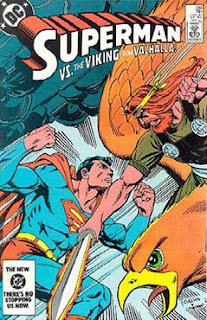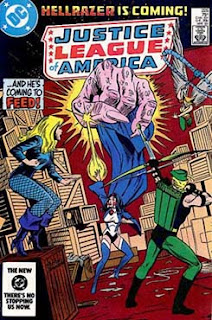Wednesday, January 22, 2025
Wednesday Comics: DC, April 1984 (week 3)
Monday, January 20, 2025
Crunch and Complexity
Last week, consideration of the new HârnMaster: Roleplaying in the World of Kèthîra and a blog post I came across in defense of heavy rules sets got me pondering what constitutes complexity and/or crunch in a rpg. Though the terms are often used interchangeably, I feel like it might be worthwhile to differentiate them.
Complexity I think speaks to the level of detail. Games tend toward greater complexity when they have one or more of the following:
- Multiple rule subsystems/exceptions to standard mechanics
- Multiple rolls required to resolve tasks/events
- Larger numbers of character qualities, particularly when they each have their own mechanics
- Figured/derived characteristics needed in play
- Tracking of multiple characteristics/variables
- Required consultation of charts
So what's crunch? I had initially thought of it essentially as math related: quantization, calculation, use of formulas, etc. Discussion with Ian of Benign Brown Beast made me reconsider. He viewed crunch as "character builds, optimal play, and interaction with the rules on their own terms (as opposed to thru the fiction)."
"Optimal play" and "interaction with rules on their own terms" are about approaches to systems, not the systems themselves, so I think those are separate phenomena. Perhaps they are a signal for the existence of crunch, though? Melding Ian's thoughts and my initial ones, I now think crunch relates to number of mechanical decision points within a system. This would show up on the player-facing side as character creation and tactical options, resulting in the potential for optimal builds in games like 3e D&D or Lancer. It also shows up in games intended to "realistically" (or at least consistently) model a wide range of genres or setting elements, like Hero System or GURPS.
In this way of viewing things, crunch can (and does) lead to complexity, but there are also factors that would lead to lengthier procedures but not necessarily options or decision points.
Friday, January 17, 2025
Two Lawful Neutral Religions
My "Hidden Religions of D&D" posts got me thinking about a new way to view alignment in D&D, and that is not as personal ethics or even (necessarily) cosmic forces, but rather as placeholders for religions within a campaign setting. Old D&D gives us some detail on the generic "Church of Law" so it would be interesting to expand that idea to other alignments--however many one wants to use.
A Lawful Neutral church would be one that holds to the supremacy of cosmic order. They would focus on the duties of individuals and society to uphold and harmonize with that cosmic order. Here are Lawful Neutral faiths that would represent these ideas in different ways.
Universal Harmony
This faith believes there is an Eternal Order that has always existed on some idealized plane, but through the process of Law that encompasses both the working of the cosmos and the virtuous behavior of the beings with that cosmos, must be made manifest. The obligations of the humanity in this work are laid out in the religion's holy text, the Formicarium.
The common person is urged to be content with their roll in life and work to make society as whole more orderly and harmonious. The contemplation of greater mysteries is left to ascetics who sometimes provide guidance on important issues to the communities they serve. Those involved in the legal system and the formulation of laws are likewise members of the clergy as law flows from and is a facet of perfect cosmic Order.
The Formicarium mandates that the ruler of a state should be a dispassionate vessel for law. Their job is to insure those under them proceed with honest and transparency, and punishment for transgressing the law is swift and impartial.
Upon death, adherents look forward to an ultimate oneness with the universal process, so that they neither suffer nor desire.
Zurthonism
Zurthon is viewed as the first principal, the transcendent god of time, space, and fate. Zurthon is sometimes called a "machine god"--a being without passion or compassion, and above concepts of good and evil. The faithful seek to divine the path Zurthon has predetermined for them from the beginning of the universe by the study of the Heavens. Zurthonist astrologer-priests plot a child's horoscope from birth. The faithful do not seek to avoid or change ill-fate but rather use this for knowledge to allow them to prepare for the future, the better to display their submission to Zurthon's divine plan.
There are heretical sects of Zurthonism that view predetermination as an excuse for licentiousness or abandon (and thus become a cult of Chaotic Neutral), but orthodox belief promotes a stoicism in all things.
Wednesday, January 15, 2025
Wednesday Comics: DC, April 1984 (week 2)
Monday, January 13, 2025
Ergodic RPG Setting Presentations
Going back to the Greyhawk Folio has made me realize how it differs from modern setting material and perhaps why I bounced off of it when I first encountered. I believe it falls into a category of published setting I would call "ergodic settings." Ergodic settings are analogous to ergodic literature, that is that are settings whose form of presentation requires nontrivial effort on the part of the reader to make sense or understand the setting.
I'll concede that "understanding" in this context can be kind of fuzzy. Different perspective DMs likely have different expectations and desires of a setting. I'm sure there are a lot of people that loved Greyhawk from the moment they encountered the Folio or the Wilderlands of High Fantasy, to name another setting I find ergodic. But I don't think that changes the quality of ergodicity, it's more about how much work you're willing to do (or have already done) to meet the setting where it is.
So what do I mean by ergodic? Well, Greyhawk in its initial present is brief, which is often touted as a virtue, but in that brevity its ability to develop an easy sense of place is impaired. It also consistently refuses to take the modern route of focusing on "juicy" details or hooks. It's not that there aren't things going on in the Flanaess, but as far as we know from the Folio, they aren't really things for low-level treasure seekers. When seeds of adventure are there, they tend to be more Game of Thrones clash of armies and intrigues. There's also perhaps a focus on wargame realism over fantasy. A careful read with an eye toward history can suggest Gygax's models and sources, but he doesn't make it easy, like say, Robert E. Howard or the first introduction to the Known World in Isle of Dread (which just tells you the inspiration, so you don't even get to feel smart!)
 |
| Well, I don't know the primary export, but these places seem cool! |
Wilderlands is similarly fairly opaque in that department, but at least you can read hexes with a crashed spacecraft, mermaids or giants. And lots of them. The Folio is dressing your set with backdrops and a few props, but with scant actual prompts for adventure and very little enticing fantasy spectacle. This is just the facts; you do most of the fantasy.
But modern settings require work because they are often too completist and too wordy! Getting through all that cruft requires work! Sure, but it's a different sort of work. It's the work of separating wheat from chaff, perhaps, or just the work of reading homework, it isn't the conceptual work of "what does this mean and what do I do with it?" The Folio approach makes it harder to distill "the good bits" for your own thing, if that's what you're after.
 |
| This Strange Stars OSR has a good approach. Wonder who wrote this? |
Now, this can be a virtue for the seasoned DM. It's easier to make it your own, perhaps, or even run it differently with the parameters that exist in different campaigns. And if all you need is the barest background to sink your dungeons into, it doesn't matter. But looking at the more recent DMs Guild Greyhawk presentations, there's more of an effort to put player-engaging material in, even as they hew fairly traditionalist.
Friday, January 10, 2025
Greyhawk: Rel Astra
Rel Astra is one of the major port cities of the Great Kingdom. It is an old city of the Aerdy, the original seat of the early Aerdian Church of Law and once a capital of an Aerdi kingdom until the crowning of the Overking. Once the Great Kingdom was declared in Rauxes, control of Rel Astra was given over to a ministerialis who served as constable and mayor in the Overking's name. The post continues, but it now belongs to a hereditary noble line whose interests have diverged from those of the Malachite Throne.
Like the lords of the Iron League region, the Constable's financial interests lie with the burghers and trade, and he resents the grasping and peremptory ways of the Overking. He is also wary of the covetousness of Medegia's Holy Censor.
While the more fierce-tongued members of the city's council urge swift action, the Constable chooses to slowly build his forces and bide his time.
The original Folio had an apparent editing mistake that listed Rel Astra as the capital of Medegia, so a thought it was worth making a nod to that in the history. Though the Folio never mentions it, the title of Overking suggests their were (at least once) subordinate kings. I figure there must have been multiple, petty Aerdian kingdoms that were united.




















.jpg)










